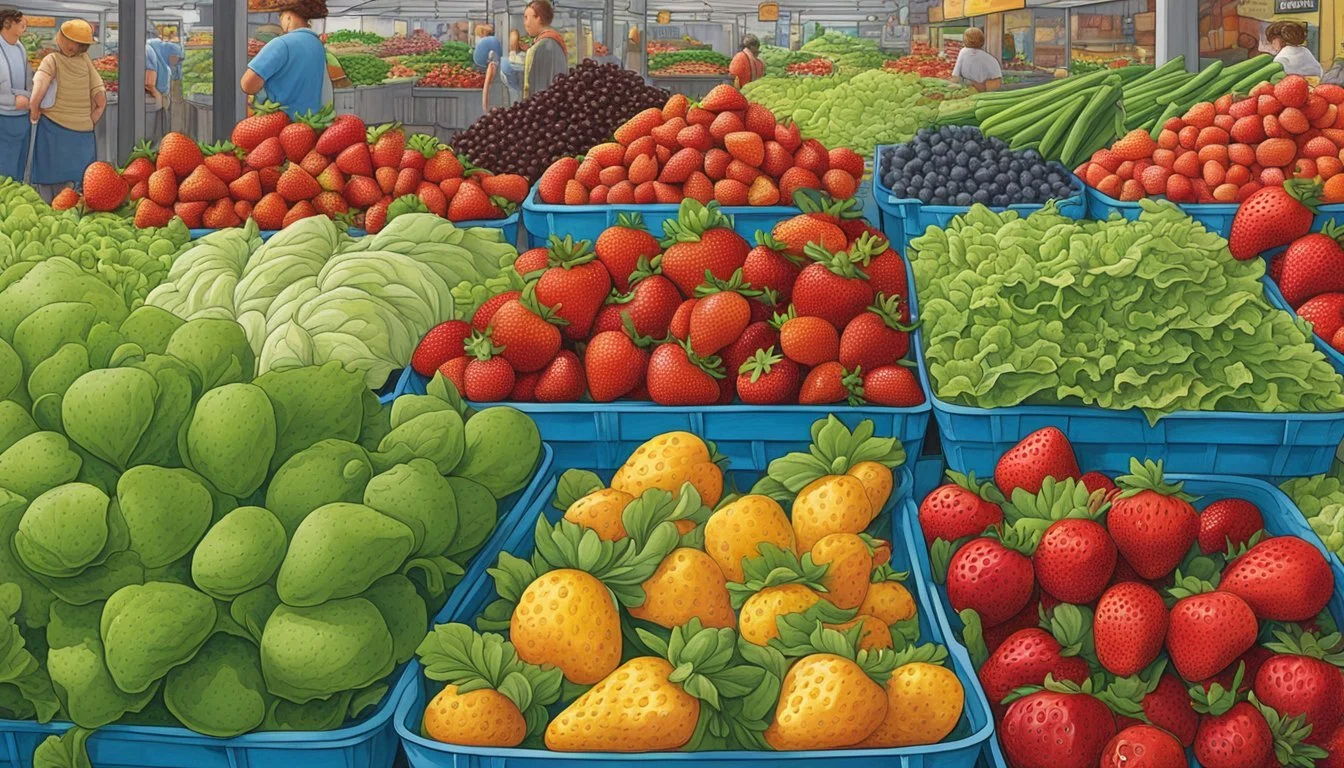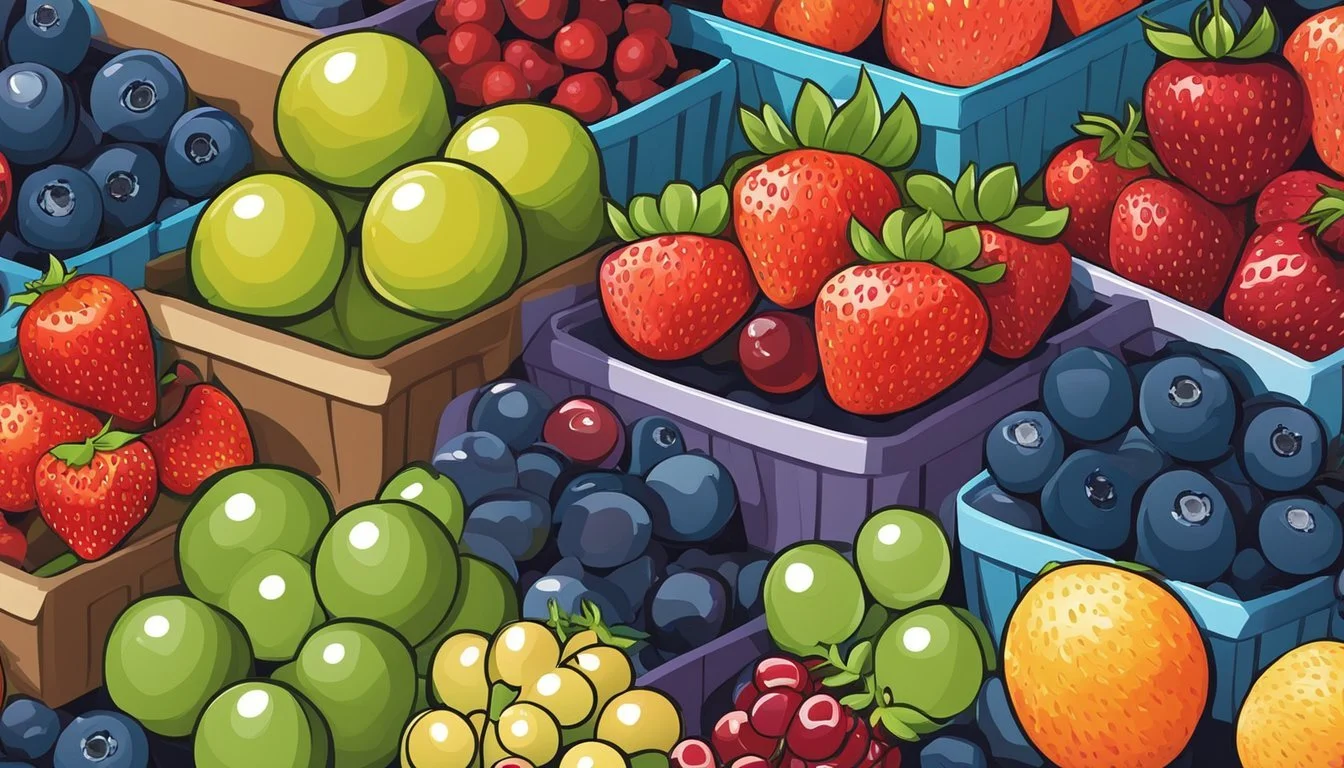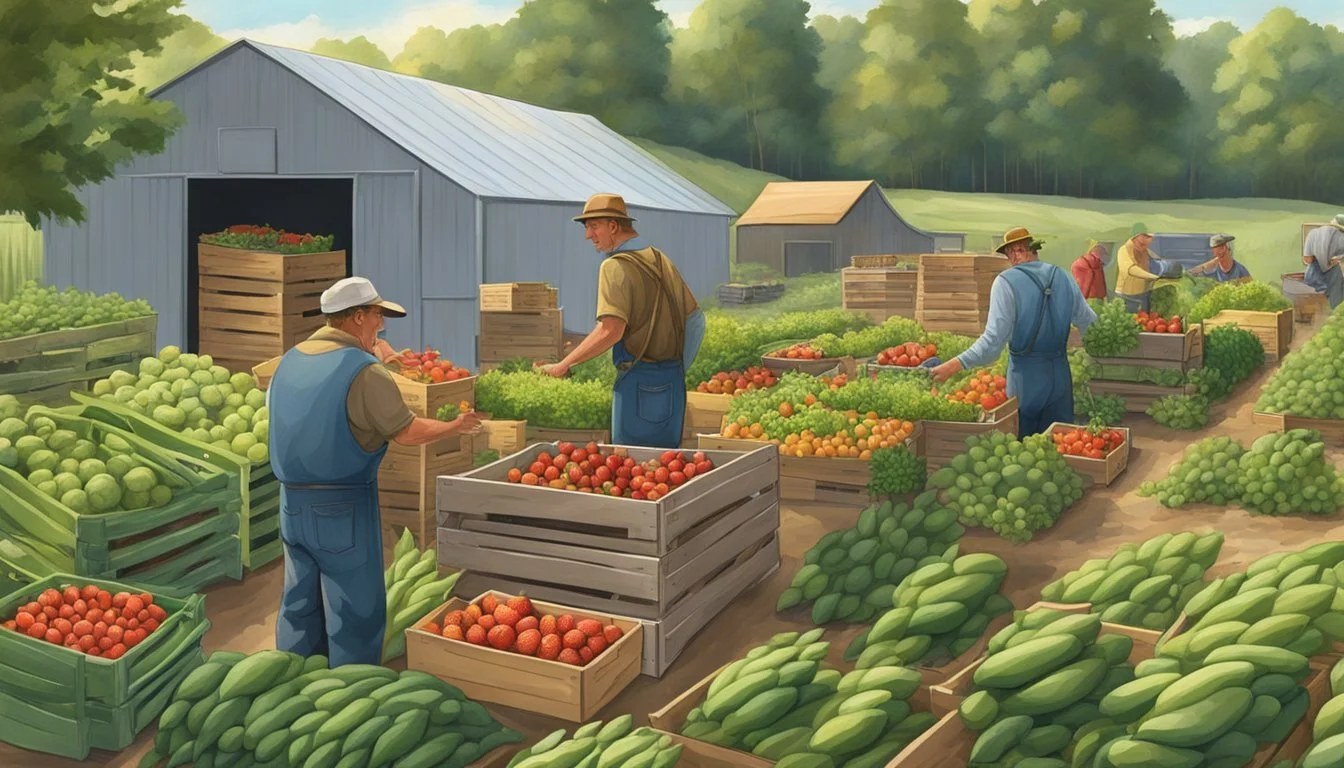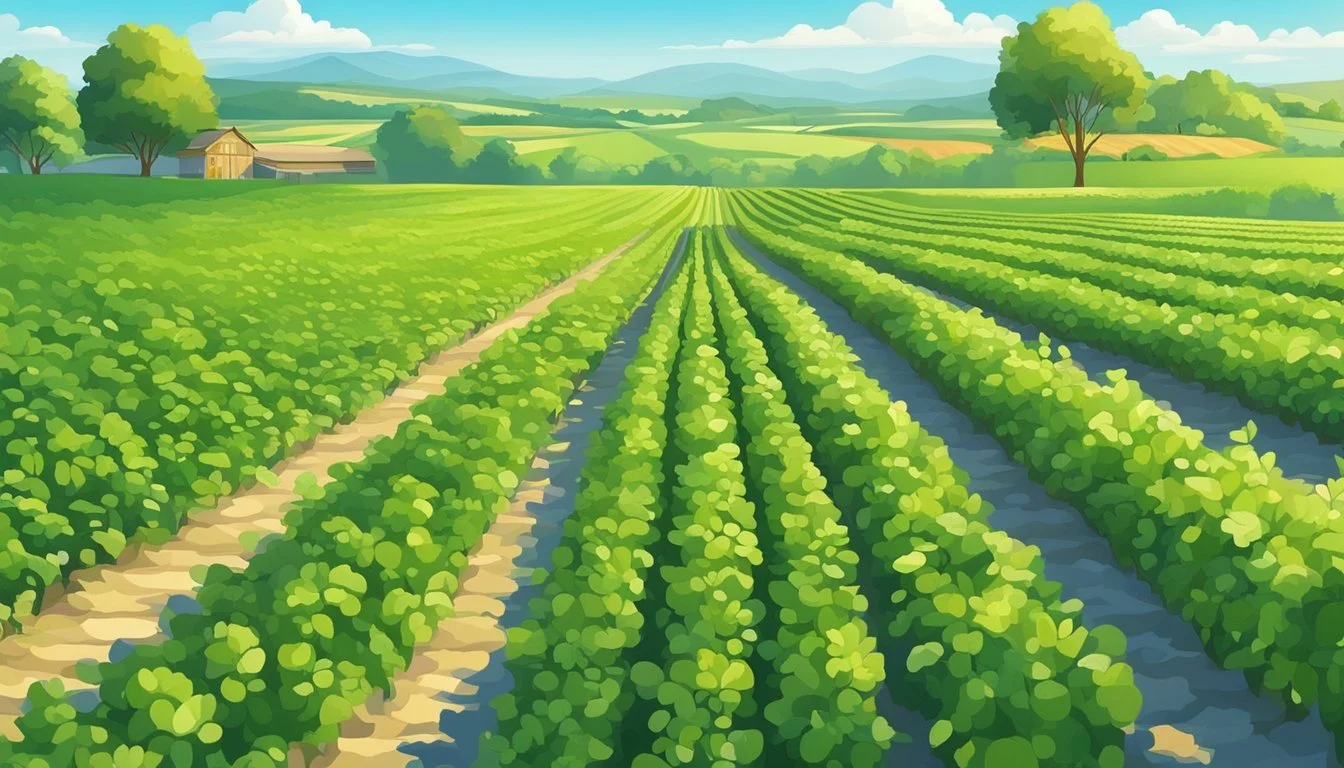Ohio Seasonal Fruit & Vegetables in May
Your Guide to Fresh Produce
This Article is Part of our Ohio Seasonal Fruit & Veg Calendar
May in Ohio brings a shift in the agricultural landscape, as the state begins to burgeon with a variety of fresh produce. This month marks a transition from the hearty root vegetables of winter to the initial offerings of spring's bounty. Ohioans start to see the arrival of tender greens, ripe radishes, and the early signs of sweet strawberries. The variety of fresh fruits and vegetables available is not only a testament to the state's rich soil but also the result of farmers' efforts to extend the growing season and maximize the availability of local produce through advanced agricultural practices.
As the days grow warmer, farmers' markets and local produce stands become vibrant with the colors of spring produce. Rhubarb and asparagus (What wine goes well with asparagus?) are among the first to appear, offering their distinctive flavors to Ohio's culinary palette. These seasonal offerings are a celebration of the state's agricultural heritage and an inviting opportunity for locals and visitors alike to experience Ohio's dedication to farm-to-table freshness. In May, the focus is on enjoying the crisp, fresh flavors that only locally sourced, freshly harvested produce can provide.
The shift in season also encourages a shift in diets, as people lean towards lighter, fresher meals after the heavier fare of winter. Incorporating seasonal fruits and vegetables into meals not only supports local agriculture but also ensures a diet rich in nutrients and taste. Ohio's seasonal produce in May provides an exciting chance for culinary exploration, as these ingredients lay the foundation for a variety of dishes that are as nourishing as they are delicious.
Overview of Ohio's Seasonal Produce
May in Ohio offers an impressive variety of fresh produce as different fruits and vegetables reach their peak growing season. This reflects the state's rich agricultural climate and the impact of seasonality on local farming.
Climate and Growing Seasons in Ohio
Ohio's climate encompasses a range of growing conditions throughout its various regions, allowing for a diverse selection of crops. In May, the temperate weather creates a favorable growing environment for spring produce. The state experiences four distinct seasons, with farmers adapting their planting schedules to make the most of the spring warmth.
Understanding Seasonality
Seasonality is the period during which certain fruits and vegetables are at their peak in flavor and abundance. In Ohio, understanding seasonality means recognizing what produce is available during different months. For produce in season in May, one can expect to find:
Vegetables: Asparagus, radishes, spinach (What wine goes well with spinach?), lettuce, and green onions
Fruits: Strawberries typically begin to appear towards the end of the month
Residents and chefs alike look for these items to ensure they get the freshest, most flavorful ingredients while supporting local agriculture.
Seasonal Vegetables in May
As May ushers in warmer days in Ohio, a distinct variety of vegetables become ripe for harvest. Gardeners and consumers alike can benefit from the fresh produce that not only imparts vibrancy to their meals but also provides substantial health advantages.
List of Vegetables Available
Asparagus: Reach its peak in May, offering a tender, fresh flavor.
Radishes: Known for their crisp texture and a peppery kick.
Spinach: Has a short season and is best when harvested early.
Lettuce: Various types mature in the cool weather of May.
Peas: Snap and snow peas are sweetest when picked this month.
Rhubarb: Although often used in desserts, it's a vegetable that's ready in May.
Health Benefits
The vegetables available in May are not only fresh but also packed with nutritional content that can aid in various aspects of health:
Asparagus is rich in fiber, folate, and vitamins A, C, and K.
Radishes are a good source of antioxidants and minerals like potassium and calcium.
Spinach provides an abundance of vitamins and iron, which is essential for healthy blood cells.
Lettuce offers hydration and is low in calories for those watching their weight.
Peas contribute a significant amount of plant-based protein and fiber.
Rhubarb contains vitamin K and calcium, beneficial for bone health.
Seasonal Fruits in May
As May ushers in warmer weather in Ohio, a limited selection of fruits start to become available, offering fresh flavors to consumers who eagerly await the arrival of the local produce season.
List of Fruits Available
Strawberries: Mid-to-late May marks the beginning of the strawberry season.
Rhubarb: Often paired with strawberries, it becomes available in May as well.
Flavor Profiles
Strawberries: These fruits come into season with a burst of sweetness and a slightly acidic tang, typically with a highly aromatic scent.
Rhubarb: It offers a tart, intense flavor that is usually tempered by cooking with sugar and often paired with strawberries to balance its sourness.
Harvesting and Storage
As spring transitions to summer in Ohio, May marks a time for both the harvest of late spring produce and the preparation of storage to extend the shelf life of these goods. It is critical for producers and consumers alike to recognize the optimal harvest periods and employ effective storage techniques to maximize freshness and availability.
Optimal Harvest Periods
Late spring in Ohio offers a limited selection of locally grown produce, as many fruits and vegetables have not yet entered their peak seasons. However, certain crops do reach maturity in May and require prompt harvesting. Greens such as spinach and lettuce are typically ready for harvest this month, as well as some herbs like parsley and cilantro. Radishes and spring onions may also be harvested. As the month progresses, local farmers prepare for the upcoming summer harvests that will include a broader range of produce.
Storage Techniques and Tips
The key to extending the life of freshly harvested produce lies in employing proper storage techniques. Each type of produce has its own storage requirements:
Leafy greens (e.g., spinach, lettuce): Store in a refrigerator's crisper drawer, loosely packed in perforated plastic bags to maintain high humidity without excess moisture.
Radishes: Remove the leafy tops to prevent moisture loss and store the roots in a plastic bag in the refrigerator's crisper drawer.
Herbs (e.g., parsley, cilantro): Store in a jar with water at room temperature for short-term use or wrap in a damp paper towel and refrigerate.
Additionally, controlling the environment in storage facilities is crucial for maintaining quality. Cooler temperatures combined with controlled humidity levels are often required to slow down the deterioration of the produce. Non-refrigerated storage should be cool and well-ventilated to prevent spoilage. Consumers can follow these storage results to enjoy Ohio's locally grown produce for an extended period.
Seasonal Recipes and Preparation Tips
In May, Ohioans enjoy a rich bounty of fresh produce. This section offers specific recipes and preparation tips for the freshest vegetables and fruits available during this month.
Vegetable-based Recipes
Ohio's May harvest brings vegetables like asparagus, mushrooms, and radishes to the forefront of seasonal cooking. One can simply grill or roast asparagus with a touch of olive oil, salt, and pepper to enhance its natural flavors. For a satisfying meal, mushrooms can be sautéed with garlic and herbs, then served over polenta or folded into omelets. Incorporating radishes into salads provides a crisp, peppery note; they can also be pickled for a tangy side dish. Below are some vegetable highlights and their corresponding preparation methods:
Asparagus: Grill with olive oil, lemon zest (how long does lemon zest last?), and a sprinkle of parmesan.
Mushrooms: Sauté with thyme and serve over a bed of greens or as a side.
Radishes: Slice raw into salads or pickle in a mixture of vinegar, water, and salt.
Fruit-centric Dishes
Moving to fruits, Ohio sees the emergence of strawberries and rhubarb in May. A classic recipe to try is a strawberry-rhubarb pie or crumble, which perfectly balances the sweetness of strawberries with the tartness of rhubarb. Strawberries can also be used in a refreshing salad, paired with spinach and a balsamic reduction. For a quick snack, dip strawberries in dark chocolate for a decadent treat. Here are some fruit preparations to enjoy:
Strawberries: Combine with rhubarb for a pie filling, or toss in salads.
Rhubarb: Stew as a compote to accompany desserts or to swirl into yogurt.
Agricultural Practices in Ohio
Ohio's diverse agricultural sector strategically adapts to the state's varying weather conditions, adopting practices that ensure sustainable farming and optimal produce yield. Farmers in Ohio understand the importance of implementing strategies that protect both the land and the economic viability of their farms.
Sustainable Farming
Farmers across Ohio are increasingly embracing sustainable farming practices. They recognize that these methodologies not only improve the quality of the land but also the longevity and health of their farming operations. Key components of sustainable agriculture in Ohio include:
Crop Rotation: Farmers use crop rotation to maintain soil health and to combat pest and weed pressure.
Conservation Tillage: Reducing tillage helps prevent soil erosion, increases water retention, and preserves soil structure.
Impact of Weather Conditions
Weather conditions in Ohio can significantly influence agricultural productivity. Farmers must remain vigilant and adaptable to the following:
Temperature Fluctuations: Ohio's spring months can experience frosts and warm spells, affecting when and what can be planted.
Precipitation Levels: Adequate rainfall is essential for crop growth, but excessive or untimely rain can lead to planting delays and diseases.
By tracking weather patterns and adjusting their practices accordingly, Ohio farmers are able to mitigate risks and ensure a successful growing season.
Buying Guide for Consumers
In May, consumers in Ohio can enjoy a variety of fresh, seasonal produce. Knowing where to purchase and how to select the best quality fruits and vegetables can enhance the culinary experience.
Where to Buy Seasonal Produce
Farmers' Markets:
Local Farmers' Markets: A prime location for fresh May produce.
Benefits: Direct from growers; often organic and non-GMO.
Retail Stores:
Grocery Stores: They may have sections for local produce.
Considerations: Look for labels indicating Ohio-grown products.
Community Supported Agriculture (CSA):
CSA Programs: Share in a local farm's harvest by purchasing a subscription box.
Advantage: Seasonal selection delivered regularly.
How to Choose Quality Produce
Fruits:
Appearance: Vibrant color, firm to the touch.
Smell: Fragrant, indicative of ripeness.
Vegetables:
Texture: Crisp, not wilting, free of blemishes.
Leaves: Look for bright, fresh-looking greens.
General Tips:
Seasonality: Understand harvest times; consult an Ohio produce calendar.
Ask: Don't hesitate to speak with vendors about the best choices.








